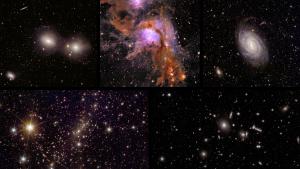EUCLID Reveals New Spectacular Images… with SPACEBEL Software
Launched from Cape Canaveral (Florida, USA) on July 1st 2023, Euclid is taking snapshots of galaxies that formed billions of years ago to help astronomers build a very precise 3D map covering a third of the sky. The 6-year study requires extremely accurate measurements and represents an impressively huge volume of various images and data.
ESA has recently released five new spectacular images of our cosmos captured by the Euclid telescope during its early observation phase.
These unprecedented views of the Universe offer scientists new insights allowing them to have a better understanding of the formation and evolution of the universe, and, in particular, the most mysterious of its fundamental components: dark energy and dark matter.
We are proud to point out that it is SPACEBEL’s control and data management software that controls the Euclid spacecraft along with its sub-systems and commands the instrument in charge of the acquisition of these stunning images.
Developed on behalf of Thales Alenia Space Italy, Euclid’s prime contractor, it is one of the most complex software systems provided by SPACEBEL to date,
Watch the ESA video to explore these groundbreaking discoveries and what they mean for the future of Space exploration.



